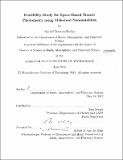Feasibility-study for space-based transit photometry using mid-sized nanosatellites
Author(s)
Bowens-Rubin, Rachel (Rachel A.)
DownloadFull printable version (12.42Mb)
Other Contributors
Massachusetts Institute of Technology. Dept. of Earth, Atmospheric, and Planetary Sciences.
Advisor
Sara Seager.
Terms of use
Metadata
Show full item recordAbstract
The photometric precision needed to measure a transit of small planets cannot be achieved by taking observations from the ground, so observations must be made from space. Mid-sized nanosatellites can provide a low-cost option for building an optical system to take these observations. The potential of using nanosatellites of varying sizes to perform transit measurements was evaluated using a theoretical noise budget, simulated exoplanet-transit data, and case studies to determine the expected results of a radial velocity followup mission and transit survey mission. Optical systems on larger mid-sized nanosatellites (such as ESPA satellites) have greater potential than smaller mid-sized nanosatellites (such as CubeSats) to detect smaller planets, detect planets around dimmer stars, and discover more transits in RV followup missions.
Description
Thesis (S.M.)--Massachusetts Institute of Technology, Dept. of Earth, Atmospheric, and Planetary Sciences, 2012. Cataloged from PDF version of thesis. Includes bibliographical references (p. 85-88).
Date issued
2012Department
Massachusetts Institute of Technology. Department of Earth, Atmospheric, and Planetary SciencesPublisher
Massachusetts Institute of Technology
Keywords
Earth, Atmospheric, and Planetary Sciences.